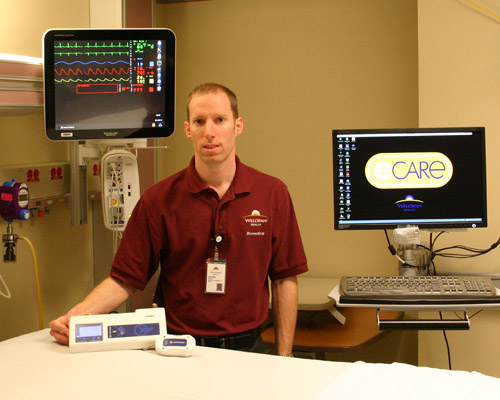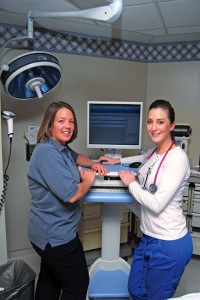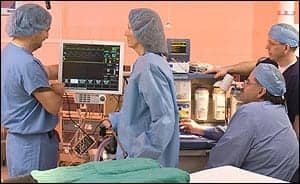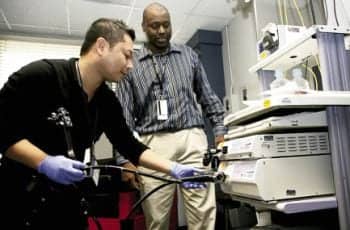A team known as Medical Equipment Information System Specialists, or MEISS, partners with key information systems groups to drive device integration
By Phyllis Hanlon
In 2006, WellSpan Health was named one of the top connected healthcare facilities by an industry publication. At the time, this hospital system had only just begun a challenging technological journey. Its path would eventually lead to the creation of a unique specialist group creating first-of-their-kind medical device integration projects.
Serving three counties in Southern Pennsylvania, WellSpan Health comprises York Hospital, Gettysburg Hospital, Ephrata Community Hospital, and the WellSpan Surgery & Rehabilitation Hospital. The lineup is completed by two regional home care organizations and 93 outpatient centers.
As the WellSpan system has grown, so, too, has its need for technology that incorporates the kinds of hardware, software, data centers, and fiber links needed to provide first-class patient care efficiently and accurately. In response, WellSpan integrated the biomed department under the greater information systems umbrella. At the same time, a specialist group was created to help integrate medical devices with patients’ electronic health records (EHRs). Known as Medical Equipment Information System Specialists, or MEISS, the group is grounded in biomedical technology with some enhancements. It partners with IS teams such as Nursing Informatics, Clinical Applications, and Technical Applications to meld their individual areas of expertise in a unique collaboration that is yielding results.
“WellSpan was looking for a group of technicians who knew equipment from a biomed standpoint, but who also knew networking, connectivity, and project management,” says MEISS member David B. Soffer, CBET, CCENT. Soffer interned at WellSpan 17 years ago, well before technology assumed its expanded role at the facility. Now, he says, “There is a trend toward integrating medical devices with electronic health records. This group has helped with our device integrations, project communication, and even budgeting for projects that involve both biomed and IT support.” As a result of this trend, he says, “Biomed is becoming the backbone of information technology. It’s the nature of our profession.”
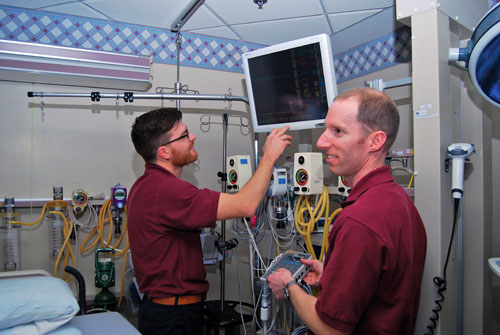
Daryl Lehman and David Soffer configure a Spacelabs monitor with a simulator for connectivity testing.
Pioneering Connectivity
WellSpan has long been on the leading edge when it comes to technology. But the organization made a giant technological leap when it began integrating medical devices with its EHR system. Its flagship connectivity project took place some 5 years ago, when the healthcare system became an alpha partner with Cerner Corp, Kansas City, Mo—its EHR vendor—in the integration of the infusion pump management system from Hospira, Lake Forest, Ill.
Thomas W. Keller II, a specialist in information systems, and Renee Howard, BSN, RN, clinical informatics nurse, explain that the year-long project enabled wireless infusion pumps to communicate with the Hospira server. “Nursing wirelessly connects to a specific infusion pump. The nurse scans the barcode from the infusion bag into the workstation. The infusion criteria—flow rate, volume, and duration—are automatically sent to the infusion pump. As the pump infuses, the infusion values are automatically sent to the electronic health record. The automatic programming and infusion management eliminate errors,” Keller says. Prior to integration, the nursing staff had to click 42 times to obtain the desired results; after integration, that number dropped to seven.
Another major device integration took place in the traditionally busy and overcrowded emergency departments and intensive care units. To ensure that patient data are captured accurately and in a timely manner in those environments and entered into the health record, MEISS integrated physiological monitors from Spacelabs Healthcare, Snoqualmie, Wash, which continuously record critical information and transmit it to the EHR.
Soffer points out in their most recent Spacelabs interface project, that once the patient’s health record is associated to the Spacelabs monitor in that particular ICU room, he or she is automatically admitted to the Spacelabs monitor. The monitor and health record immediately begin to communicate, and the physiological information is transmitted to the EHR. When the patient leaves the ICU room, the nurse disassociates the patient from the workstation and the patient is discharged from the Spacelabs monitor. “Not having to admit and discharge on the Spacelabs saves a step for nursing and is spot-on accurate,” Soffer says. Prior to the integration, when a patient was not admitted to the room, important data could be lost.
WellSpan’s 32 operating rooms and other surgical areas also use Spacelabs monitors to measure and record physiologic and anesthesia values, according to Soffer. “The anesthesiologist doesn’t have to write anything down. It’s time-saving not having to manually document, and it improves accuracy.”
Mini Projects
In addition to major integration efforts, WellSpan sometimes undertakes small projects that save the nursing staff valuable time and produce reliable information. Some smaller integration endeavors include cardiac output monitors from Edwards Life Sciences Corp, Irvine, Calif, Prismaflex dialysis systems from Gambro, Toronto, and balloon pumps from Maquet, Rastatt, Germany. These projects take only about 6 to 8 weeks to complete. “Usually, they are not time-intensive. We probably spend 2 to 3 hours a week during that time frame to work on the projects,” Soffer reports.
Also, such projects that involve fewer than 20 devices can easily be completed without significant financial input, since the hardware and EHR screen may already be built to accommodate the device.
The integration of blood pressure machines from Welch Allyn, Skaneateles Falls, NY, took slightly longer, since there are about 240 devices throughout the health system. Each once needed updated software and licensing, and had to be connected to the wireless network with individual accounts, according to Soffer. “We needed barcode scanners, and nursing informatics had to do some educating. But the payback is amazing. The amount of time the nurses save and the accuracy going into the electronic health record is a good return on investment,” he says. Previously, the nurses would document values on paper and then type them into their workstations every time they took a vitals measurement. “Now, the values appear on the screen and are automatically populated into the electronic health record.”
Interestingly, after a pilot of Welch Allyn connectivity in only one nursing unit, their patient fall rate diminished to almost zero. This prompted a clinical study, and it is hoped that the same fall rate improvement will occur throughout the entire health system now that it has Welch Allyn connectivity.
It Takes a Team
Potential connectivity projects get their start during the monthly meetings with management and the manager of networking. “We try to eliminate hallway conversations and bring them to the meeting,” Soffer says. When a nurse or department makes a request, the group reviews it and its viability, and then sends it to leadership for evaluation to see whether the device falls within the connectivity parameters. In some instances, devices have not been designed with the features necessary for connectivity. Until manufacturers update those devices, a process that often requires considerable time and money, integration has to be put on hold. The MEISS team also takes an inventory of the devices, which allows them to estimate the manpower, time, equipment, and financial investment they will need to complete the project.
Coordinating, researching, designing, and implementing these integration projects requires several skilled hands. Keller, a WellSpan employee since 2003, brings his expertise in digital integration to MEISS. His familiarity with the more technical aspects of the projects complements the biomedical technicians’ knowledge base. “The concept of training biomed technicians in integration began in the early 1990s. The idea was to make them cognizant of system thinking. The creation of MEISS has been a good natural evolution,” he says. “You need an intermediary group that can bring biomed and information systems together. You need to take biomed from a device mentality to a system mentality.”
Keller contributes to the device configuration during the early stages of integration, and his experience helps with troubleshooting after the project is completed. In one instance, communication between wireless infusion pumps and the EHR was interrupted. Upon investigation, he discovered that the number of devices operating concurrently was overwhelming the system. He brought this information to the manufacturer, who opened more wireless channels to accommodate the workload, thus solving the problem.
Two years ago, Daryl Lehman, CCENT (Cisco Certified Entry Networking Technician), was working as a biomedical OR anesthesia specialist in the operating room at WellSpan. He’d been exposed to the networking side of healthcare for years, but when he joined MEISS, he was able to focus exclusively on this area.
Having worked as a biomed technician, Lehman has a great appreciation for what MEISS does. He acknowledges the importance of integration, but points out that when information technology brings in new IS equipment and attaches it to existing machines, biomed technicians often find the project rollout obtrusive. “The biomed technician should be involved, but doesn’t always have time while focusing on equipment repair and preventative maintenance. When you’re doing day-to-day responsibilities, it creates a challenge. The MEISS team helps facilitate improved interaction between traditional biomed and IT,” he explains.
As a separate team dedicated to integrating medical devices, MEISS helps to bridge the gap between biomed technicians who are doing the daily work of maintaining equipment and specialists who are advancing the facility’s technology, according to Lehman. “[MEISS] takes the pressure off by keeping up with the connectivity side and coordinating ahead of time with the biomed techs,” Lehman notes. “We’re making changes while still respecting their domain. When I was in that role, we didn’t have the luxury of a team smoothing the bumps over. Now we engage [the biomed techs], but do not expect them to do heavy lifting.”
Lehman adds that each segment of the MEISS team has its own specific functions, but sometimes the lines get blurred. “What I do now is not necessarily the same as what I signed up for. But we didn’t really know how the role would evolve,” Lehman says. “That’s part of the satisfaction—not having to fit a prescribed role. We do what needs to be done.”
Nursing and Technical Input
Renee Howard began at WellSpan 6 years ago in the open-heart ICU. An admitted technology geek, she jumped at the chance to become a “SuperUser”—a nurse with enhanced technological knowledge and skills to assist in the training of technological advancements. “I was still in my nursing role and helping to care for patients, but helping my fellow nurses at the same time to learn new technology. I loved being a SuperUser,” she says. Joining Clinical Nursing Informatics (under the WellSpan IS umbrella) was a natural next step. “I have the bedside experience. I still spend time with nurses and patients, and have become a liaison between bedside nurses and the tech world,” she says. “I quickly learned to speak IT.”
Howard plays a pivotal role in the integration process. She consults with the technical team to figure out which devices to connect and what values to capture. Her clinical experience enables her to determine what information to include in the EHR. Her technological training allows her to assist in configuring and testing devices.
In some cases, the device itself presents a roadblock to integration, according to Howard. A majority of devices are not wireless and must be connected to a special plug-in wall adapter. “The nurses want the patients up and moving around,” she says, pointing out that this cannot happen if a device requires connection to a USB port. Some devices are not configured at all for connectivity with the EHR, so project requests have to be denied.
While the biomed techs and nursing lend important medical perspective and knowledge to these integration projects, technological know-how is also a vital component. In addition to Keller, who brings a strong networking background to the group, technical and clinical applications specialists serve behind the scenes to extrapolate the data to make sure it is compatible with the EHR. Angie Jowanowitch, senior systems data analyst, is in charge of the iBus, an application that transports discrete physiologic data and infusion data from medical devices into the EHR or consuming application for viewing or verification by a clinician.
When she started working at WellSpan 6 years ago, Jowanowitch was thrust into the integration projects, a dramatic switch from her previous positions. “I came from a developer background and did projects for EDS on a health insurance application,” she explains. As part of the IS team, she sits in on the monthly meetings and becomes involved in projects from their inception. “I have to know what each device needs and how to configure it.”
Probably the most challenging project to date has been the implementation of infusion management, according to Jowanowitch. “It took us a good year to implement. But our team was solidified with this project. We realized that no one can work alone.”
The technical specialists also serve as a help desk for hospital staff who call when devices fail to perform as expected. “My team takes a look at the problem and tries to resolve it,” Jowanowitch says. “Depending on the device, we go to the appropriate server to see if the data is coming in. We try to find the ‘break’ point.” She adds, however, that her team receives few calls, due to extensive pretesting. “We’re in a stable place,” she says. “These projects provide a huge benefit for clinicians, and the time it saves them allows for better patient care. The clinical staff does not have to spend so much time calculating and entering data.”
Prior to any project implementation, MEISS takes advantage of the excellent on-site simulation laboratories and testing facilities to identify potential glitches. Keller notes that support from WellSpan leadership makes such opportunities possible. “WellSpan is known for its unique training and testing laboratories and environment. When we buy a new product, we also buy a test server for testing in a non-patient environment,” he notes. “We do connectivity simulations where we bring equipment in and simulate data flow.”
Soffer explains further that before any device “goes live,” it undergoes intense testing. “We have a simulation lab where we test the devices on a mannequin. Once the device passes all connectivity tests, we roll it out and educate staff. We make sure everyone knows how to use the new connectivity feature of the device.”
Educating Staff
Education is not limited to clinical staff. Soffer, Keller, and Lehman have written step-by-step instruction manuals for the biomed and technical staff in PDF format, explaining how to set up the device and get onto the network. “The instruction manual has screenshots, settings, and all technical information,” he points out. There are also special documents that provide information for IP addresses and port settings. These manuals assist biomed technicians who might be on call when a problem arises. “They need to know how to program and fix the devices. Illustrations provide visuals for additional help,” Soffer says. Portions of the documents are shared with the IS help desk manager to create flow charts for improved help desk support.
The MEISS team also conducts in-service trainings at staff meetings. The IT educational team offers computer-based training as well as a written manual. Howard does hands-on training in various clinical departments within the hospital. “A few of us go with a cart and attend staff meetings and do hands-on demonstrations. The nurses already know how to use the equipment. They just need to learn how to use the connectivity,” Howard says. “My role is more of a support mode with device connectivity. The learning curve is small compared to the switch from paper to computer. WellSpan has been computerized since 2006. These mini-education information sessions help staff become oriented to the devices.”
These in-person training sessions also help the nurse managers understand the value in integrating the medical devices. “In the beginning, they thought it would be adding another step,” Howard says. “But it actually took away three or four steps.”
WellSpan’s success with its integration projects has led to greater national recognition for the facility and its MEISS team. Howard and Keller have presented at various conferences and medical forums, and conducted webinars. Howard has also published a white paper on WellSpan’s infusion connectivity pump.
The shift in thinking at WellSpan has created a new model that is grabbing the attention of other healthcare systems. By moving biomedical technicians away from strict equipment maintenance and preventative care toward the role of integrating medical devices with electronic health records, WellSpan’s MEISS team serves as an example of efficiency, cost-effectiveness, and innovation that other health systems are sure to follow. 24×7
Top Photo: Wellspan’s Thomas W. Keller II, Daryl Lehman, Angie Jowanowitch, Renee Howard, and David Soffer.
Phyllis Hanlon is a contributing writer for 24×7. For more information, contact editorial director John Bethune at [email protected].


